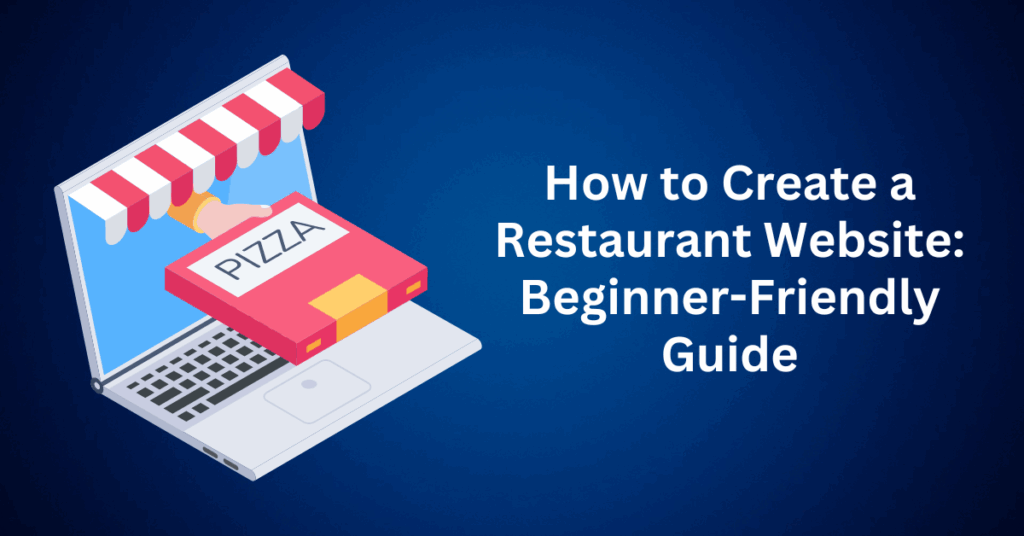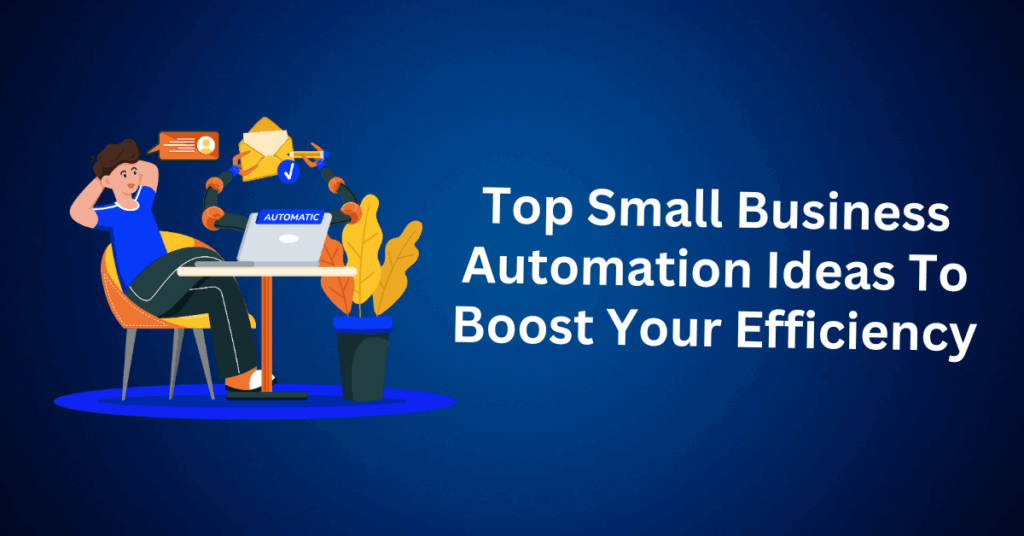Today, whether people are buying a product, booking a service, or planning a night out, they almost always start online. Naturally, restaurants and cafés are no exception. In fact, your restaurant website is often the very first interaction potential customers have with your brand. Think of it as your digital front door setting expectations about your atmosphere, cuisine, and overall vibe.
However, if your website isn’t visually compelling, easy to navigate, or doesn’t clearly highlight what makes your restaurant unique, you could be missing out on valuable guests. In the hospitality industry, building an engaging website isn’t just a marketing tactic, it’s a smart business move that can directly impact your bottom line.
The best part? You don’t need a tech background to make it happen. With the right restaurant website builder and a bit of creativity, you can craft an online presence that mirrors the warmth and personality of your dining space. Even better, it becomes easy for customers to browse your menu, book a table, or place an online order with just a few clicks.
So, whether you’re launching a brand-new restaurant or refreshing an existing site, this step-by-step guide will walk you through everything you need to know to turn online visitors into loyal diners.
How to Build a Restaurant Website That Reflects Your Brand Identity
When it comes to restaurant website design, your goal should be to create a seamless extension of your physical space. Your website should tell your story, showcase your food, and invite customers to experience your brand before they even set foot inside.
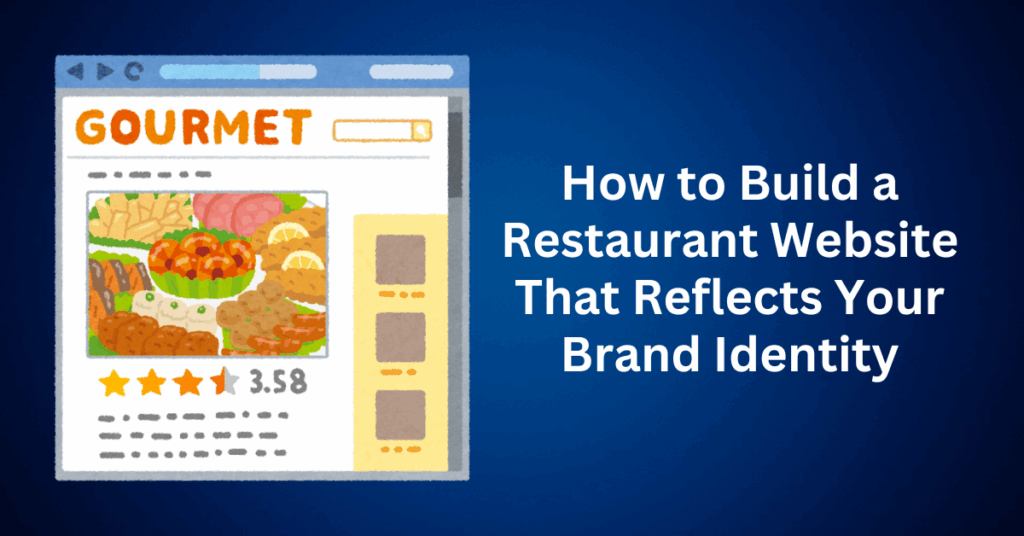
Here’s how to create a restaurant website that truly captures your restaurant’s unique spirit:
1. Define Your Restaurant Branding in Your Website
Think of your brand like the soul of your restaurant. Whether your space is cozy and rustic, elegant and sophisticated, or fun and eclectic, your website should immediately communicate that personality.
- Establish a consistent tone of voice: Whether casual, playful, romantic, or refined, your written content should feel authentic to your brand.
- Use imagery and colours that match your vibe: Every photo and graphic should feel like it belongs in your dining room.
- Maintain consistency: Ensure that your tone, visuals, and messaging flow seamlessly across every page.
2. Choose a Colour Palette That Shows Your Restaurant’s Atmosphere
Colour isn’t just about aesthetics, it creates emotional connections.
- Pick 2–3 primary colours that complement your decor, menu items, or overall brand theme.
- Stay consistent across your site to create a polished, professional look.
- Use colour intentionally to guide visitors’ attention to key actions like reservations or online ordering.
3. Select Consistent and Readable Typography
Fonts can make or break the user experience on your site. Choose fonts that are not only stylish but also easy to read.
- Use no more than two fonts: One for headings and one for body text.
- Create a visual hierarchy: Use font size and weight (like bold or italic) strategically to make the website easy to navigate.
- Stay uniform across all pages to maintain a cohesive, professional appearance.
4. Feature Your Logo Prominently in Your Restaurant Website
Your logo is the visual cornerstone of your brand, so it’s important to make sure it’s instantly recognizable and easy for visitors to associate with your restaurant. To create a seamless user experience, place your logo in the top-left corner of your website. This is where most users naturally expect to find it.
Additionally, link your logo back to the homepage to make site navigation simple and intuitive. Finally, always use a high-resolution version of your logo to ensure it appears crisp and clear across all screen sizes and devices.
5. Tell Your Brand Story Through Authentic Copy
People connect with stories, not just products or services. Share the passion behind your restaurant.
- Talk about your journey: What inspired you to open your restaurant? What fuels your passion for food?
- Introduce your team or head chef: Personal touches create emotional connections with customers.
- Highlight your values: Whether it’s farm-to-table ingredients or a commitment to sustainability, share what sets you apart.
6. Showcase Signature Dishes and Chef Specials
Your food should be the star of your website. Tempt visitors by putting your most irresistible dishes front and center.
- Highlight 2–3 standout menu items with mouth-watering descriptions.
- Link these items directly to your full menu or online ordering system.
- Incorporate rich visuals or short videos to spark cravings immediately.
7. Use High-Quality, Authentic Photography
Nothing sells your food better than stunning, high-quality images. That’s why investing in professional photography is one of the smartest moves you can make for your restaurant’s online presence. Capturing your dishes, interiors, and special events through a professional lens not only highlights the quality of your offerings but also conveys the unique atmosphere of your space.
Avoid using generic stock photos, as they can feel impersonal and misleading. Real photos of your actual food and environment help build authenticity and trust with potential guests. To keep your website fresh and relevant, make it a habit to refresh your gallery seasonally or whenever you introduce new menu items or update your décor.
8. Connect Your Social Media Channels
Social media is a powerful way to extend your brand experience beyond the confines of your website. By connecting with guests on platforms like Instagram, Facebook, and TikTok, you can keep your restaurant top-of-mind and build lasting relationships.
To encourage engagement, include social media icons in your website’s header or footer, making it easy for visitors to find and follow your profiles. You can also embed an Instagram feed or feature your latest posts directly on your homepage to give guests a real-time glimpse into your food, atmosphere, and events.
Additionally, showcasing customer reviews and user-generated content helps build credibility and a sense of community. When people see others enjoying your restaurant, they’re more likely to trust your brand and want to experience it for themselves.
9. Share Your Restaurant’s Mission and Core Values
Today’s diners care about more than just great food. Instead, they want to support brands that reflect their values. That’s why it’s important to dedicate a section of your website to your mission and what drives your business beyond profits.
Use this space to highlight what sets you apart, whether it’s sustainable practices, ethical sourcing, or meaningful involvement in your local community. Sharing your values and the positive impact your restaurant strives to make helps guests feel more connected to your brand.
Additionally, featuring charitable initiatives or partnerships not only showcases your commitment to giving back but also fosters deeper customer loyalty. When diners see that their support contributes to a greater purpose, they’re more likely to return and to share your story with others.
10. Prioritize Clean, Mobile-Friendly Website Design
A sleek, intuitive website design is essential for helping customers find what they need quickly, whether they’re browsing your menu, making a reservation, or placing an online order. A well-structured layout not only enhances usability but also leaves a lasting impression of professionalism and care.
Start by using clear, straightforward navigation with easily accessible buttons and compelling calls-to-action that guide visitors seamlessly through your site. It’s also crucial to ensure your website is fully optimized for mobile devices, as most users will be visiting from their smartphones. A responsive design guarantees your site looks great and functions well on any screen size.
Finally, don’t overlook performance. Regularly test your site speed and loading times to ensure a smooth, frustration-free experience. A fast, user-friendly website keeps potential guests engaged and more likely to follow through with a booking or order.
Essential Features Every Great Restaurant Website Needs
When it comes to winning over new customers, a beautiful website design is only part of the equation. The true secret to an effective restaurant website lies in how useful and user-friendly it is. If you want your website to do more than just look good, actually to bring hungry visitors through your doors, you’ll need to include a few essential features that create a smooth, satisfying experience.
Whether you’re launching a brand-new restaurant or giving your online presence a much-needed refresh, here’s exactly what your website should include:
1. An Easy-to-Find, Up-to-Date Menu
The menu is usually the first thing a potential guest wants to see, so it’s important to make it easy to find, easy to read, and easy to get excited about. Start by creating a dedicated “Menu” page that is clearly visible in your main navigation. Offer an option for visitors to view the menu online or download a PDF for their convenience.
When writing your menu, craft tempting descriptions for each dish and clearly list the prices. Organize the menu into intuitive sections such as appetizers, entrees, desserts, and drinks to make browsing effortless and enjoyable. An organized, mouth-watering menu can instantly turn casual browsers into eager diners.
2. A Simple, Streamlined Reservation System
In today’s fast-paced world, most customers prefer the convenience of booking a table online rather than picking up the phone. That’s why offering a smooth, hassle-free reservation process can significantly boost your bookings. To get started, integrate a reliable reservation tool like OpenTable, Resy, or even a custom form built with WPForms. Be sure that the system allows guests to easily select their preferred date, time, party size, and leave any special requests.
To further enhance the user experience, place your “Reserve a Table” button in a highly visible spot on your homepage for quick access. After all, removing any friction from the reservation process makes it easier for guests to commit, and more filled tables follow. It’s as simple as that.
3. Integrated Online Ordering and Delivery Options
Online ordering isn’t just a nice-to-have anymore. It’s a must for modern restaurants. If you offer takeout or delivery, it’s crucial to make the process effortless for customers. Partner with platforms like UberEats, DoorDash, Zomato, or use WooCommerce for direct online orders through your own site.
To encourage more orders, add eye-catching “Order Now” buttons across your site, especially on your homepage and menu page. Also, make sure your ordering system is mobile-friendly, since many users will be browsing and ordering from their phones. Convenience is king, so make sure you’re capturing those craving-driven impulse orders!
4. Interactive Location Map and Contact Information
Your contact page should do more than just list an address. It should actively help visitors find you and get in touch. Start by embedding a clickable Google Map so guests can easily navigate to your location. Make sure to clearly display your business hours, address, phone number, and email address in an easy-to-read format.
If you have multiple locations, consider offering a simple location finder tool to streamline the process for your visitors. Being accessible and easy to reach isn’t just convenient, it’s also a huge trust builder for new customers.
5. Showcase Positive Customer Reviews and Testimonials
Social proof is incredibly powerful; in fact, glowing reviews are often the deciding factor for someone choosing your restaurant over a competitor. To leverage this, feature standout customer testimonials prominently either on your homepage or a dedicated “Reviews” page. By showcasing real feedback from trusted platforms like Google Reviews, Yelp, or Facebook, you not only boost authenticity but also build trust with potential guests.
Additionally, make it a regular practice to encourage satisfied customers to share their experiences. This can be done by sending follow-up emails or placing friendly reminders on signage throughout your restaurant. While word-of-mouth is always valuable, it’s important to remember that online praise is even more influential in today’s digital landscape.
6. Stunning, Authentic Food and Atmosphere Photography
You eat with your eyes first and your website visitors are no different. That’s why high-quality images are essential; they can spark cravings and immediately convey the atmosphere of your restaurant. To truly capture your space at its best, consider hiring a professional photographer to showcase your signature dishes, cozy interiors, and happy diners enjoying their meals.
Moreover, avoid using generic stock photos. Authenticity is key, and real images create a genuine connection with potential guests. To keep your site fresh and engaging, regularly update your gallery with new content. Think seasonal dishes, festive décor, or snapshots from special events. These vivid, real-life photos help bring your restaurant’s story to life and invite guests to experience it firsthand.
When you combine compelling visuals with practical features, your restaurant website becomes far more than a digital business card. Instead, it transforms into a powerful marketing tool that drives reservations, encourages online orders, and fosters lasting customer loyalty.
Now that you understand the must-have features, it’s time to choose the right website builder to bring your vision to life. Stay tuned and we’ll be breaking down the best restaurant website builders to help you create a stunning, functional site with ease.
Best Platforms to Build a Restaurant Website: Find the Perfect Fit for Your Business
When it comes to building a restaurant website, your choice of platform matters just as much as choosing the right oven for your kitchen. It needs to match your style, your goals, and your level of technical skill.
Whether you’re looking for a quick, beginner-friendly setup or a fully customizable website you can scale with your growing business, there’s a restaurant website builder perfectly suited to your needs.
Below, we break down the top options, including WordPress with Bluehost, Wix Restaurant, Squarespace, and Shopify, so you can find the right fit to showcase your menu, take reservations, and even sell products online.
Quick Comparison: Top Restaurant Website Builders
| Feature | Bluehost WordPress | Wix Restaurant | Squarespace | Shopify |
| Ease of Use | Very easy | Very easy | Easy | Easy |
| Customization | High | Moderate | Moderate | High |
| Best For | Full control, scalability | Beginners, quick setup | Visual storytelling | Selling food/products online |
| Price Range | $2.95–$13.95/month | Free–$24/month | $16–$49/month | $29–$299/month |
| SEO Tools | Advanced (Yoast SEO, etc.) | Built-in | Built-in | Built-in |
| Online Ordering | Plugin-based (WooCommerce) | Built-in | Third-party apps | Built-in |
| Reservation System | Plugin-based (OpenTable) | Built-in | Third-party integration | Third-party integration |
| Mobile Responsive | Yes | Yes | Yes | Yes |
| Hosting & Security | Free SSL, secure hosting | SSL & Wix hosting | SSL & included hosting | Secure hosting, SSL |
| Payment Integration | Via plugins | Built-in | Built-in | Built-in |
| Customer Support | 24/7 live chat & phone | Email & chat | Live chat | 24/7 support |
Note: Pricing and features are subject to change.
This comparison gives you a clear look at what each platform offers from customization freedom to built-in ordering systems and mobile optimization, helping you make a more informed choice for your restaurant’s digital presence.
1. Bluehost with WordPress: Maximum Flexibility and Growth Potential
If you’re serious about building a restaurant brand online and want full creative and functional control, WordPress with Bluehost is a standout choice.
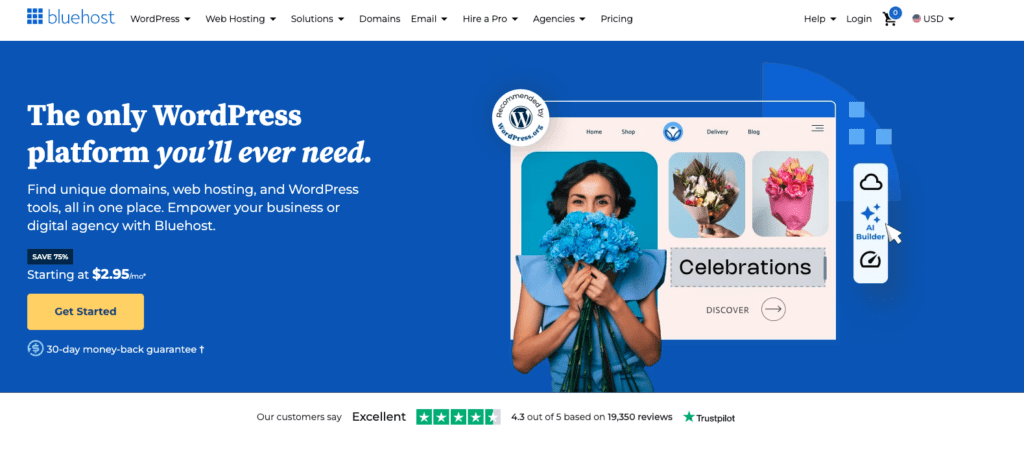
With WordPress, you have access to thousands of restaurant themes and plugins that allow you to add features like online ordering, reservation forms, event calendars, blogs, and photo galleries. Bluehost makes the setup easy with one-click WordPress installation, a free custom domain for your first year, and 24/7 customer support to keep your site running smoothly.
Key Features:
- One-click WordPress installation
- Access to SEO tools like Yoast
- Huge selection of restaurant-friendly themes (Astra, OceanWP)
- Plugin compatibility for online ordering (WooCommerce) and reservations (OpenTable)
- Free SSL certificate and secure web hosting
- Easy blogging, menu creation, and photo galleries
Best for: Restaurants planning to scale, add ecommerce, or heavily customize their website over time.
2. Wix Restaurant: Quick and Visual Website Setup
For restaurant owners who want a fast, beautiful website without needing to touch any code, Wix Restaurant is a top contender.
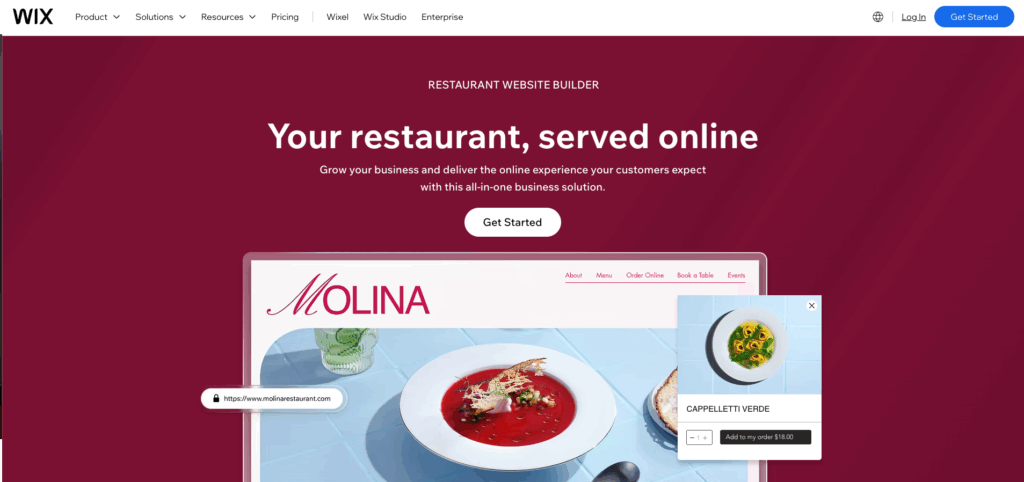
Wix’s drag-and-drop editor makes designing your site feel effortless. Plus, it offers dedicated restaurant templates, a built-in online ordering system, and simple reservation tools through Wix Bookings.
Key Features:
- Restaurant-specific templates ready to customize
- Built-in online menu, ordering, and delivery options
- Reservation system and event booking features
- Mobile-friendly, visually stunning layouts
- Marketing tools like email campaigns and social media integrations
Best for: Busy owners who want to get online quickly with minimal hassle and maximum design flexibility.
3. Squarespace: Modern, Elegant Websites for Restaurant Storytelling
If you want your website to feel like an extension of your restaurant’s atmosphere, Squarespace is ideal for creating sleek, polished designs that tell your story.
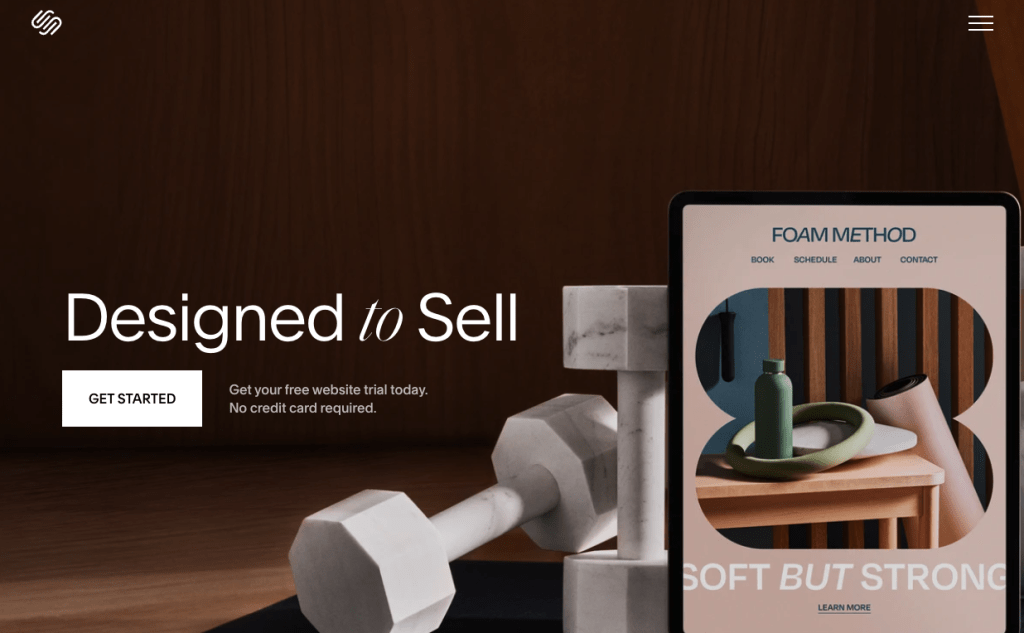
Squarespace offers beautiful, mobile-responsive templates perfect for showcasing professional food photography, updating menus, and integrating OpenTable for online reservations. It’s also SEO-optimized, making it easier for local customers to find you.
Key Features:
- Stunning, image-focused templates
- Built-in SEO best practices
- Easy updates for menus, specials, and events
- OpenTable reservation integrations
- Social media and email marketing features
- Mobile-ready and analytics built-in
Best for: Restaurants that want a visually immersive experience and strong local SEO presence.
4. Shopify: Best for Restaurants Selling Food Products Online
If selling online is a major part of your restaurant’s business model, think catering, packaged foods, merchandise, or DIY kits. Shopify is the strongest platform for ecommerce success.
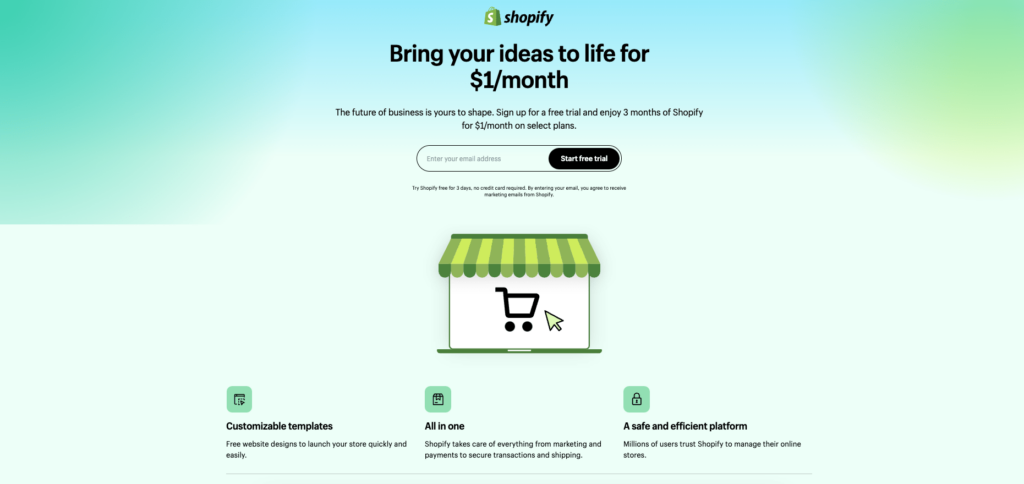
Shopify makes it easy to manage inventory, take online orders, set up local delivery or pickup, and even integrate your restaurant’s physical POS system with your online store.
Key Features:
- Built-in ecommerce platform and payment processing
- Inventory management for food, merch, and kits
- POS system integration for seamless online/offline sales
- Secure hosting with free SSL
- Mobile-optimized templates
- Access to powerful SEO and marketing apps
Best for: Restaurants that want to expand their revenue by selling products or meals directly online.
Final Thoughts: How to Create a Restaurant Website: Beginner-Friendly Guide
In today’s digital world, your restaurant website is far more than just a place to display your menu. It’s the heart of your brand’s online identity. Not only does a well-designed site tell your story, but it also showcases your food and gives customers a taste of your hospitality before they even step through the door.
Therefore, choosing the right platform to build your restaurant website can make all the difference. Whether you’re aiming for seamless online ordering, easy reservation management, or simply a beautiful space to highlight your signature dishes, the right tools can help you stand out in a crowded marketplace.
Fortunately, with Bluehost WordPress hosting, you gain full control over your design, functionality, and growth potential. From mobile-friendly layouts to powerful SEO capabilities and endless customization options, you can create a stunning, user-friendly website that drives real results, turning visitors into loyal customers.
So, don’t just build a website. Instead, build an experience.
Launch your restaurant’s online presence with Bluehost WordPress today and start serving up success!
